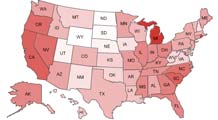How to really help troubled homeowners
Tying mortgage modification to affordability lowers redefault rate, federal study finds. Regulators press banks to keep in mind borrowers' ability to pay.
NEW YORK (CNNMoney.com) -- It may seem obvious: Increasing how much troubled borrowers pay on their mortgage leads to redefaults. But that didn't stop America's banks.
Until the end of last year, the majority of loan modifications either increased homeowners' monthly payments or left them unchanged. Not surprisingly, more than half of those borrowers fell behind again within six months.
Loan servicers, the companies that collect mortgage payments and work with borrowers in default, have gotten the message.
A government report released Friday found that about half of modifications made in the fourth quarter decreased payments.
And reducing payments leads to fewer redefaults. Only 23% of borrowers whose monthly tabs were lowered by more than 10% in the third quarter had fallen behind in their payments within six months, according to the Office of the Comptroller of the Currency and the Office of Thrift Supervision.
This compares with 46% of borrowers whose payments rose by more than 10% and 51% whose payments were unchanged.
"In stressful economic times, modifications that increase monthly payments or keep them the same are likely to run the risk of unacceptably high redefault rates," said Comptroller of the Currency John Dugan.
There are two main reasons for the disconnect between what seems like common sense and servicers' early response.
When the mortgage meltdown first started in 2007, servicers approached loan modifications in the typical way -- tacking on missed payments and penalties to the principal, which increased the monthly tab.
Also, servicers were constrained by contracts with investors who bought mortgage-backed securities, said Joseph Evers, deputy comptroller for large banks.
As foreclosures soared, however, servicers and investors grew more open to lowering payments, as long as it was more cost effective than foreclosing on the home.
"This crisis is more severe," Evers said. "The traditional approach of loss mitigation may not be the right approach in this environment."
The regulators created a stir in December when they reported that more than 50% of modified mortgages were delinquent six months later. Modification advocates -- including Federal Deposit Insurance Corp. Chair Sheila Bair -- blasted the study for not detailing the how the mortgages were modified.
The Obama administration, financial institutions and housing counselors are counting on loan modifications to pull the nation out of the mortgage crisis. They are at the center of the president's housing plan, which he announced in February.
The program subsidizes interest rate reductions so that borrowers' payments are no more than 31% of their gross monthly income. Many large servicers -- as well as mortgage financiers Fannie Mae (FNM, Fortune 500) and Freddie Mac (FRE, Fortune 500) -- have implemented initiatives in recent months that tie modifications to affordability.
But modifications' effectiveness in reducing foreclosures in the long run remains to be seen. That's why redefault rates are being so closely monitored.
In reviewing banks' fourth-quarter modification efforts, the regulators asked about the types of modifications being done. They found that by year's end institutions were doing many more modifications that lowered payments, rather than leaving them unchanged or raising them.
Some 50.7% of modifications in the fourth quarter decreased payments, compared to 35.7% in the first quarter.
Overall, however, redefault rates are rising. Some 43% of loans modified in the third quarter were at least 60 days delinquent after five months, compared with 37.6% of second-quarter adjustments and 31.4% of first-quarter efforts.
The report has spurred regulators to push financial institutions to take affordability into account when doing modifications.
"We have gone back to each of the servicers and directed them to review their modification polices to ensure they are designed to produce sustainable mortgages," Dugan said.
Some servicers, however, are still complaining about the constraints placed on them by investors' contracts.
"That's something they'll have to work through with their investors," Evers said.
The study also raised new concerns about how soon the housing market would recover. The percentage of seriously delinquent prime loans -- held by borrowers with the strongest credit backgrounds -- grew to a record 2.4% at the end of the fourth quarter. This is up from 1.11% at the end of the first quarter.
Regulators are monitoring these figures, since the prime mortgages are considered the lowest risk and account for two-thirds of all loans in the study.
"We watch that very carefully because to the extent we see problems there, it affects a much wider swath of mortgages outstanding in the United States," Dugan said of prime mortgages. "Historically, that's the highest we've ever seen prime mortgages." ![]()


